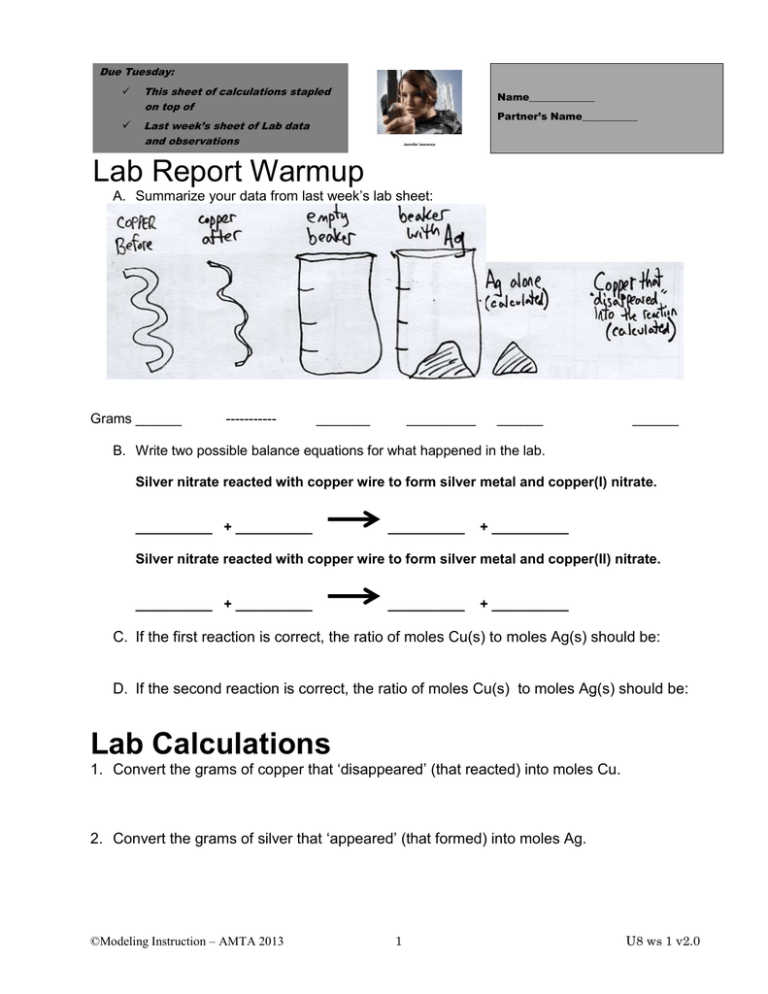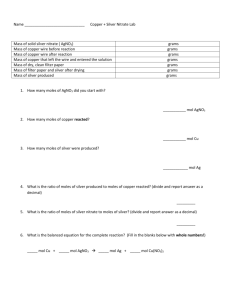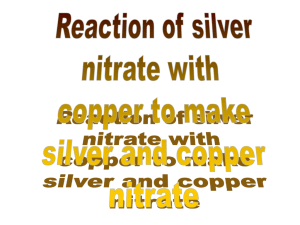Lawrence Sheet
advertisement

Due Tuesday: This sheet of calculations stapled on top of Last week’s sheet of Lab data and observations Name_____________ Partner’s Name___________ Jennifer lawrence Lab Report Warmup A. Summarize your data from last week’s lab sheet: Grams ______ ----------- _______ _________ ______ ______ B. Write two possible balance equations for what happened in the lab. Silver nitrate reacted with copper wire to form silver metal and copper(I) nitrate. __________ + __________ __________ + __________ Silver nitrate reacted with copper wire to form silver metal and copper(II) nitrate. __________ + __________ __________ + __________ C. If the first reaction is correct, the ratio of moles Cu(s) to moles Ag(s) should be: D. If the second reaction is correct, the ratio of moles Cu(s) to moles Ag(s) should be: Lab Calculations 1. Convert the grams of copper that ‘disappeared’ (that reacted) into moles Cu. 2. Convert the grams of silver that ‘appeared’ (that formed) into moles Ag. ©Modeling Instruction – AMTA 2013 1 U8 ws 1 v2.0 moles Ag . Be sure to use the appropriate SF. Write molesCu your result on the board to share with the class. 3. Determine the value of the ratio: 4. The AgNO3 was pre-measured to be 1.0 gram. How many moles of AgNO3 were us in the lab? 5. Determine the value of the ratio: moles Ag . Be sure to use the appropriate SF. moles AgNO3 Analysis 1. Because of our deep and abiding belief that atoms react in simple integer ratios, what moles Ag produced do you suppose is the actual ratio of ? You should use class results molesCu consumed for #3 to help you decide the correct value. From your answer, and what you wrote in today’s warmup, write the balanced equation for the reaction between copper and silver nitrate. 2. Using the grams of copper that reacted (that were used up) determine a) theoretical yield in grams of silver (formulas are on the front) [in other words, based on grams of Cu wire reacted to grams of Ag that should have formed.] b) Determine the % yield of silver moles Ag produced is greater than the accepted value, then either the moles molesCu consumed of Ag is too high, or the moles of Cu is too low. If your ratio is lower than the accepted value, then either the moles of Ag is too low, or the moles of Cu is too high. Use the % yield to help you decide whether the problem is due to the value you have obtained for the moles of silver. List at least one specific experimental error that could account for ratio being too high or too low. 3. If your ratio ©Modeling Instruction – AMTA 2013 2 U8 ws 1 v2.0


